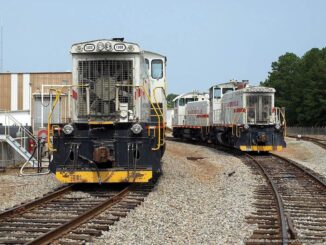ROSWELL, Ga. – Today, not a foot of railroad track lies in this Atlanta suburb.
And surrounding communities, such as Dunwoody, offer a similar fate, unless modern-day subway tracks count. But, less than 100 years ago, a narrow-gauge short line railroad once served this community, connecting it to a major thoroughfare between Charlotte and Atlanta.
Beginning in 1881, trains operated from Roswell Junction — modern-day Chamblee — to just before Roswell, on the banks of the Chattahoochee River.
The history of the railroad, however, dates back to 1853, when Roswell King, then president of the Roswell Manufacturing Company, envisioned a railroad. The company, which operated on the western bank of the Chattahoochee River, saw potential economic benefits to a railroad.
“King asked his shareholders for authority to build a narrow-gauge railroad without specifying in which direction the road would be built,” Les R. Winn writes in his 1995 book Ghost Trains & Depots of Georgia. “The authorization was quickly given.”
Once authorized, King had to decide which direction to build the line. Winn notes there were two possible directions to reach a mainline — 12 miles to the Western & Atlantic Railroad in Marietta or 18 miles to Atlanta.
“Indecision, because of the high cost of construction caused the prudent King and his company to delay building any track,” Winn wrote. “With the start of the Civil War, there was a high demand for the textiles made by the Roswell Manufacturing Company.”
Despite the war, King’s company obtained a charter on April 10, 1863. The intent was to build a narrow-gauge railroad to carry both passengers and freight. However, a depleted stock of steel in the Confederacy dashed any hopes of building a line. Thus, the waiting game began.
A year later, in 1864, the Roswell Manufacturing Company was destroyed in Gen. William T. Sherman’s famous Atlanta campaign. It would not be until six years later, in 1870, that the construction of a railroad to Roswell would even be considered.
It was that year that the Atlanta & Richmond Air-Line announced its intentions to build a road between Atlanta and Richmond. In 1877, the company “went into receivership and was sold to the Clyde family and their Richmond & West Point Terminal (Railway) & Warehouse Company,” Winn notes.
It would be another four years until the Roswell Railroad would finish construction between Roswell and Roswell Junction. And even then, tracks stopped at the Chattahoochee River, though original plans called for the railroad to terminate in the town’s square. Costs, however, stalled and ultimately killed the planned construction of a bridge over the river.
When the railroad opened on Sept. 1, 1881, it was controlled by the Atlanta & Charlotte Air-Line Railroad Company. The Richmond & Danville Railroad leased the Atlanta and Charlotte Air-Line Railroad Company. The Richmond & Danville Railroad became a part of Southern Railways in 1894.
In 1903, Southern Railways converted Roswell Railroad’s track to standard gauge, matching its systems tracks. At that time, the railroad also built a spur line, known as the Bull Sluice Railroad. The 2.7-mile of tracks joined the Roswell Railroad just north of the Dunwoody station.
In 1908, the town of Chamblee was incorporated, essentially in a circle around Southern Railways’ depot.
At the railroad’s heyday, between 1903 and 1920, two trains operated over the tracks each day. However, as the 1920s approached, the rising cost of operating trains became too great and in 1921, the tracks were removed.
Today, much of the railroad’s roadbed has been built over, roads and buildings covering the old path.
Published in the September 2004 edition of The Cross-Tie.





